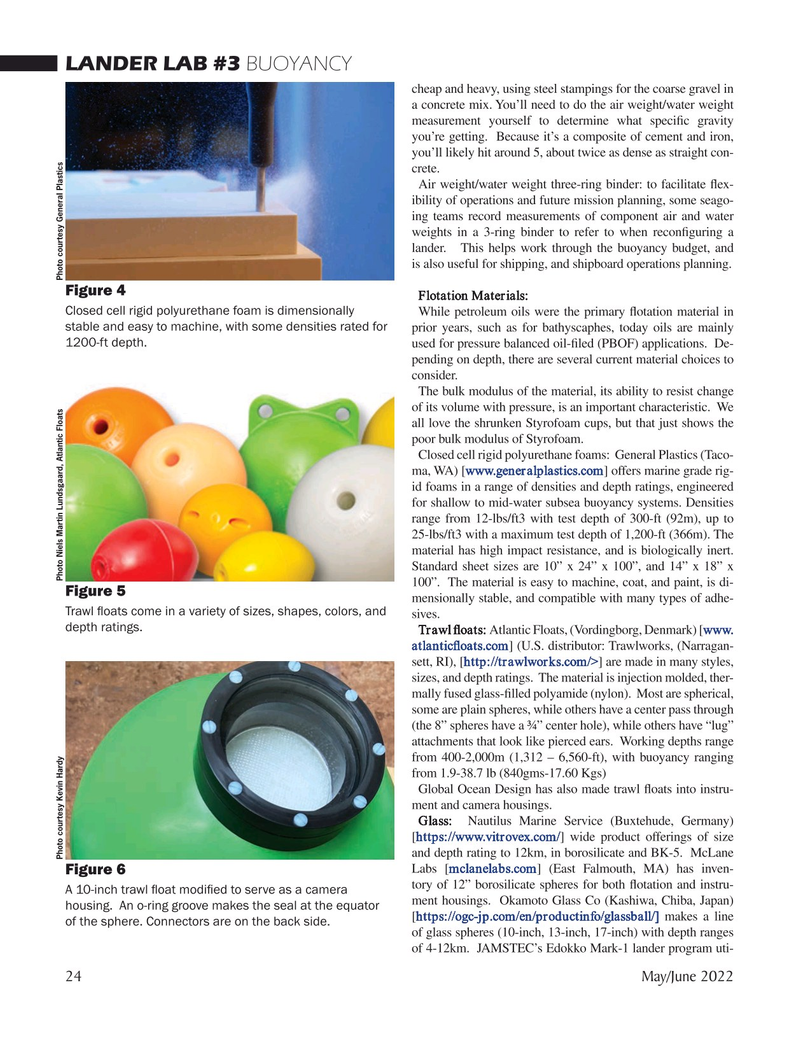
Page 24: of Marine Technology Magazine (May 2022)
Read this page in Pdf, Flash or Html5 edition of May 2022 Marine Technology Magazine
LANDER LAB #3 BUOYANCY cheap and heavy, using steel stampings for the coarse gravel in a concrete mix. You’ll need to do the air weight/water weight measurement yourself to determine what speci? c gravity you’re getting. Because it’s a composite of cement and iron, you’ll likely hit around 5, about twice as dense as straight con- crete.
Air weight/water weight three-ring binder: to facilitate ? ex- ibility of operations and future mission planning, some seago- ing teams record measurements of component air and water weights in a 3-ring binder to refer to when recon? guring a lander. This helps work through the buoyancy budget, and is also useful for shipping, and shipboard operations planning.
Figure 4
Flotation Materials:
Closed cell rigid polyurethane foam is dimensionally While petroleum oils were the primary ? otation material in stable and easy to machine, with some densities rated for prior years, such as for bathyscaphes, today oils are mainly 1200-ft depth. used for pressure balanced oil-? led (PBOF) applications. De- pending on depth, there are several current material choices to consider.
The bulk modulus of the material, its ability to resist change of its volume with pressure, is an important characteristic. We all love the shrunken Styrofoam cups, but that just shows the poor bulk modulus of Styrofoam.
Closed cell rigid polyurethane foams: General Plastics (Taco- ma, WA) [www.generalplastics.com] offers marine grade rig- id foams in a range of densities and depth ratings, engineered for shallow to mid-water subsea buoyancy systems. Densities range from 12-lbs/ft3 with test depth of 300-ft (92m), up to 25-lbs/ft3 with a maximum test depth of 1,200-ft (366m). The material has high impact resistance, and is biologically inert.
Standard sheet sizes are 10” x 24” x 100”, and 14” x 18” x 100”. The material is easy to machine, coat, and paint, is di-
Figure 5 mensionally stable, and compatible with many types of adhe-
Trawl ? oats come in a variety of sizes, shapes, colors, and sives. depth ratings.
Trawl ? oats: Atlantic Floats, (Vordingborg, Denmark) [www.
atlantic? oats.com] (U.S. distributor: Trawlworks, (Narragan- sett, RI), [http://trawlworks.com/>] are made in many styles, sizes, and depth ratings. The material is injection molded, ther- mally fused glass-? lled polyamide (nylon). Most are spherical, some are plain spheres, while others have a center pass through (the 8” spheres have a ¾” center hole), while others have “lug” attachments that look like pierced ears. Working depths range from 400-2,000m (1,312 – 6,560-ft), with buoyancy ranging from 1.9-38.7 lb (840gms-17.60 Kgs)
Global Ocean Design has also made trawl ? oats into instru- ment and camera housings.
Glass: Nautilus Marine Service (Buxtehude, Germany) [https://www.vitrovex.com/] wide product offerings of size and depth rating to 12km, in borosilicate and BK-5. McLane
Photo courtesy Kevin Hardy Photo Niels Martin Lundsgaard, Atlantic Floats Photo courtesy General Plastics
Labs [mclanelabs.com] (East Falmouth, MA) has inven-
Figure 6 tory of 12” borosilicate spheres for both ? otation and instru-
A 10-inch trawl ? oat modi? ed to serve as a camera ment housings. Okamoto Glass Co (Kashiwa, Chiba, Japan) housing. An o-ring groove makes the seal at the equator [https://ogc-jp.com/en/productinfo/glassball/] makes a line of the sphere. Connectors are on the back side. of glass spheres (10-inch, 13-inch, 17-inch) with depth ranges of 4-12km. JAMSTEC’s Edokko Mark-1 lander program uti- 24 May/June 2022
MTR #4 (18-33).indd 24 4/25/2022 10:17:01 AM

 23
23

 25
25
